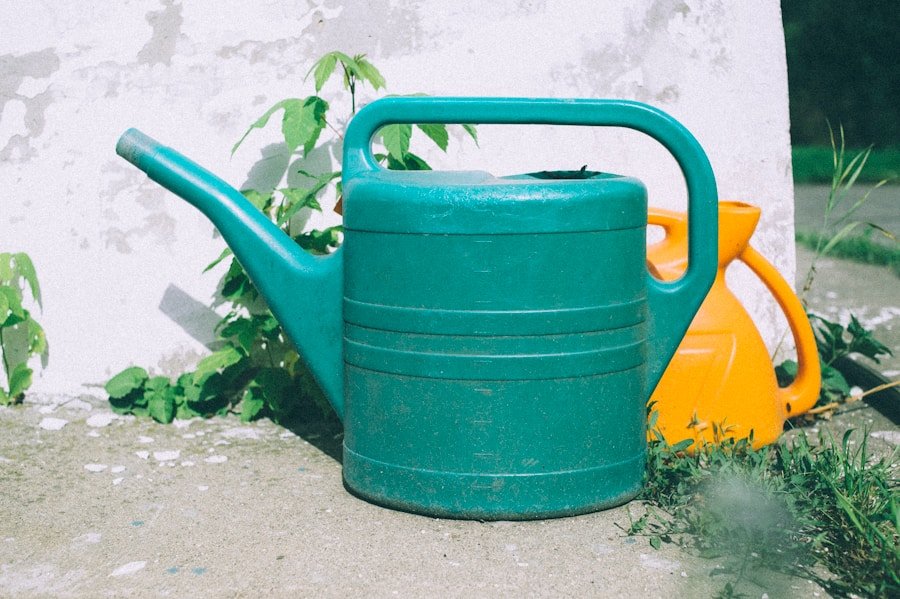When cultivating garlic indoors, it is essential to comprehend the watering requirements of the plants to ensure their overall well-being and development. Garlic plants necessitate consistent moisture, but excessive watering can lead to root rot and other problems. A delicate balance must be struck between maintaining soil moisture and avoiding waterlogged conditions.
Typically, garlic plants require approximately 1 inch of water per week, although this may vary depending on factors such as temperature, humidity, and the type of soil and containers used. Regular monitoring of soil moisture levels is crucial, and the frequency of watering should be adjusted as needed to prevent overwatering. In addition to the quantity of water, the timing of watering is also critical.
Garlic plants generally benefit from infrequent, deep watering rather than frequent shallow watering. This encourages the roots to grow deeper into the soil, enabling the plants to better withstand dry periods. When watering indoor garlic plants, it is recommended to water in the morning, allowing any excess moisture to evaporate during the day and reducing the risk of fungal diseases.
By understanding the specific watering needs of indoor garlic plants, gardeners can take proactive measures to prevent overwatering and promote healthy growth.
Key Takeaways
- Understanding the water needs of indoor garlic plants is crucial for preventing overwatering.
- Choosing the right soil and containers with proper drainage is essential for maintaining the right moisture levels for garlic plants.
- Monitoring soil moisture levels regularly can help prevent overwatering and ensure the health of indoor garlic plants.
- Adjusting watering frequency based on plant growth and environmental conditions can prevent overwatering and promote healthy garlic growth.
- Identifying signs of overwatering and following tips for preventing overwatering can help maintain a thriving indoor garlic garden.
Choosing the Right Soil and Containers for Garlic
Optimal Soil Conditions
Garlic plants thrive in well-draining, loamy soil rich in organic matter. This type of soil allows excess water to drain away from the roots, reducing the risk of overwatering. It’s essential to avoid heavy, compacted soils that can retain too much moisture and lead to waterlogged conditions. Adding organic matter like compost or peat moss to the soil mix can improve drainage.
Choosing the Right Containers
Selecting the right containers is crucial for preventing overwatering. Containers should have drainage holes at the bottom to allow excess water to escape, preventing water from pooling at the bottom of the container and saturating the roots. Using containers with a saucer or tray underneath can catch any excess water that drains out, preventing it from sitting in the soil and causing overwatering issues.
Creating a Healthy Environment
By selecting the right soil and containers, gardeners can create an environment that promotes healthy root growth and reduces the risk of overwatering. This careful attention to detail can lead to a successful indoor garlic harvest.
Monitoring Soil Moisture Levels
One of the most effective ways to prevent overwatering in indoor garlic gardens is to monitor the soil moisture levels regularly. This can be done using a simple moisture meter or by inserting a finger into the soil to feel for moisture. It’s important to check the moisture levels at different depths in the soil, as surface moisture levels can be deceiving.
By monitoring the soil moisture levels, gardeners can determine when it’s time to water and when it’s best to hold off to prevent overwatering. In addition to using a moisture meter or finger test, gardeners can also keep an eye on the appearance of the soil. Overwatered soil may appear soggy or have a foul odor, indicating that it’s holding too much moisture.
Dry, cracked soil may indicate that it’s time to water. By paying attention to these visual cues, gardeners can adjust their watering practices accordingly and prevent overwatering in their indoor garlic gardens.
Using Proper Drainage Techniques
| Prevent Overwatering in Your Indoor Garlic Garden |
|---|
| 1. Use well-draining soil to avoid waterlogged conditions. |
| 2. Allow the soil to dry out slightly between waterings. |
| 3. Monitor the moisture level by checking the soil with your finger. |
| 4. Avoid watering on a fixed schedule and adjust based on plant needs. |
| 5. Provide adequate drainage in the plant container to prevent water accumulation. |
Proper drainage is essential for preventing overwatering in indoor garlic gardens. In addition to choosing well-draining soil and containers with drainage holes, gardeners can also use additional techniques to improve drainage and reduce the risk of overwatering. One effective method is to add a layer of gravel or small stones at the bottom of the container before adding the soil.
This creates a space for excess water to drain away from the roots, reducing the risk of waterlogged conditions. Another drainage technique is to use a potting mix specifically designed for container gardening, as these mixes are often formulated to improve drainage and aeration. Gardeners can also consider using raised beds or elevated platforms for their indoor garlic gardens to further improve drainage and prevent water from pooling around the roots.
By implementing proper drainage techniques, gardeners can create an environment that promotes healthy root growth and reduces the risk of overwatering in their indoor garlic gardens.
Adjusting Watering Frequency Based on Plant Growth
As indoor garlic plants grow and develop, their watering needs may change, requiring gardeners to adjust their watering frequency accordingly. Young garlic plants may require more frequent watering as they establish their root systems, while mature plants may need less frequent watering as they become more established. It’s important for gardeners to pay attention to the growth stage of their garlic plants and adjust their watering practices accordingly to prevent overwatering.
In addition to plant growth stage, environmental factors such as temperature and humidity can also influence the watering needs of indoor garlic plants. During hot, dry periods, plants may require more frequent watering to maintain adequate moisture levels, while cooler, more humid conditions may require less frequent watering. By adjusting watering frequency based on plant growth and environmental conditions, gardeners can prevent overwatering and promote healthy growth in their indoor garlic gardens.
Identifying Signs of Overwatering in Garlic Plants
Recognizing the Visual Cues
To prevent overwatering in indoor garlic gardens, it’s essential to identify the signs of overwatering in the plants. Some common signs of overwatering in garlic plants include yellowing or wilting leaves, stunted growth, and a foul odor coming from the soil. Overwatered plants may also develop root rot, which can cause the roots to become mushy and discolored.
Monitoring Plant Response to Watering
By recognizing these signs, gardeners can take proactive steps to adjust their watering practices and prevent overwatering in their indoor garlic gardens. In addition to visual cues, gardeners can also pay attention to how their garlic plants respond to watering. If plants show signs of stress or decline after being watered, it may indicate that they are being overwatered.
Adjusting Watering Practices
Conversely, if plants perk up and show improved growth after being watered, it may indicate that they were in need of moisture. By paying attention to these signs and adjusting watering practices accordingly, gardeners can prevent overwatering and promote healthy growth in their indoor garlic gardens.
Tips for Preventing Overwatering in Indoor Garlic Gardens
In addition to understanding the watering needs of indoor garlic plants and implementing proper drainage techniques, there are several additional tips that gardeners can follow to prevent overwatering in their indoor garlic gardens. One tip is to avoid using saucers or trays underneath containers that can collect excess water and lead to waterlogged conditions. Instead, gardeners can place containers on top of elevated platforms or use pot feet to allow excess water to drain away freely.
Another tip is to avoid overhead watering methods that can lead to excess moisture on the leaves and increase the risk of fungal diseases. Instead, gardeners can use a drip irrigation system or water directly at the base of the plants to deliver water where it’s needed most without saturating the leaves. Additionally, allowing the soil surface to dry out between waterings can help prevent overwatering by allowing excess moisture to evaporate before the next watering cycle.
By following these tips and taking proactive steps to prevent overwatering, gardeners can create an environment that promotes healthy growth and prevents waterlogged conditions in their indoor garlic gardens. In conclusion, preventing overwatering in indoor garlic gardens requires a combination of understanding the specific watering needs of garlic plants, choosing the right soil and containers, monitoring soil moisture levels, using proper drainage techniques, adjusting watering frequency based on plant growth, identifying signs of overwatering, and following additional tips for preventing overwatering. By taking proactive steps and paying attention to visual cues and plant responses, gardeners can create an environment that promotes healthy growth and prevents overwatering in their indoor garlic gardens.
With proper care and attention, indoor garlic gardens can thrive and produce bountiful harvests without succumbing to overwatering issues.
FAQs
What is overwatering and why is it harmful for indoor garlic plants?
Overwatering is when plants receive more water than they need, leading to waterlogged soil and root rot. For indoor garlic plants, overwatering can inhibit proper root development and lead to stunted growth or even plant death.
How often should indoor garlic plants be watered?
Indoor garlic plants should be watered when the top inch of soil feels dry to the touch. This typically translates to watering every 7-10 days, but frequency may vary depending on factors such as humidity and temperature.
What are some signs of overwatering in indoor garlic plants?
Signs of overwatering in indoor garlic plants include yellowing or wilting leaves, mold or mildew growth on the soil surface, and a foul odor emanating from the soil.
How can I prevent overwatering in my indoor garlic garden?
To prevent overwatering, use well-draining soil and pots with drainage holes. Water plants only when the top inch of soil is dry, and avoid letting water accumulate in the saucer or tray beneath the pot.
Can I use a moisture meter to prevent overwatering in my indoor garlic garden?
Yes, a moisture meter can be a helpful tool for gauging when to water indoor garlic plants. Insert the meter into the soil and water only when the reading indicates that the soil is dry.


